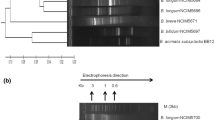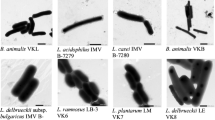Abstract
Two essential requirements for probiotic bifidobacteria are that they be “live” and have “colonization” ability, following FAO/WHO guideline recommendations. The amount of research on the adhesion ability of bifidobacteria compares poorly with that of other probiotic bacteria, such as lactobacilli. The aim of the present study was to determine how gastrointestinal conditions affect the adhesion ability of bifidobacteria, and to investigate the relationship between the adhesion ability and the live/dead state of bifidobacteria. The adhesion ability of Bifidobacterium animalis KLDS2.0603 that had been subjected to the digestive enzymes, pepsin, trypsin, and proteinase K, was decreased significantly, but these treatments did not significantly change the strain’s survival rates, which were 98.78%, 97.60%, and 97.63% respectively. B. animalis KLDS2.0603 subjected to LiCl retained its adhesion ability but had a lower survival rate (59.28%) than the control group (P<0.01). B. animalis KLDS 2.0603 subjected to sodium metaperiodate exhibited higher adhesion ability than the control group (P<0.01), but the bacterial cells were killed totally. The results of transmission electron microscopy and laser scanning confocal microscopy showed that live/dead state of bifidobacteria was not one of the main factors that affected the adhesion ability of bifidobacteira, and that the substances affecting the adhesion ability of bifidobacteria were on the outer surface layer of the bifidobacterial cells. Our results also indicated that the substances related to the adhesion ability of bifidobacteria are proteinaceous. The above results will help us to understand the adhesion and colonization processes of bifidobacteria in the human gastrointestinal tract.
Similar content being viewed by others
References
Ananta, E. and Knorr, D. 2004. Evidence on the role of protein biosynthesis in the induction of heat tolerance of Lactobacillus rhamnosus GG by pressure pre-treatment. Int. J. Food Microbiol. 96, 307–313.
Bernet, M.F., Brassart, D., Neeser, J.R., and Servin, A.L. 1993. Adhesion of human bifidobacterial strains to cultured human intestinal epithelial cells and inhibition of enteropathogen-cell interactions. Appl. Environ. Microbiol. 59, 4121–4128.
Bezkorovainy, A. 2001. Probiotics: determinants of survival and growth in the gut. Am. J. Clin. Nutr. 73, 399S–405S.
Candela, M., Seibold, G., Vitali, B., Lachenmaier, S., Eikmanns, B.J., and Brigidi, P. 2005. Real-time PCR quantification of bacterial adhesion to Caco-2 cells: competition between bifidobacteria and enteropathogens. Res. Microbiol. 156, 887–895.
Canzi, E., Guglielmetti, S., Mora, D., Tamagnini, I., and Parini, C. 2005. Conditions affecting cell surface properties of human intestinal bifidobacteria. Antonie van Leeuwenhoek 88, 207–219.
Collado, M.C., Meriluoto, J., and Salminen, S. 2007. Development of new probiotics by strain combinations: is it possible to improve the adhesion to intestinal mucus? J. Dairy Sci. 90, 2710–2716.
Collado, M.C., Meriluoto, J., and Salminen, S. 2008. Adhesion and aggregation properties of probiotic and pathogen strains. Eur. Food Res. Technol. 226, 1065–1073.
Deepika, G., Green, R.J., Frazier, R.A., and Charalampopoulos, D. 2009. Effect of growth time on the surface and adhesion properties of Lactobacillus rhamnosus GG. J. Appl. Microbiol. 107, 1230–1240.
Del Re, B., Sgorbati, B., Miglioli, M., and Palenzona, D. 2000. Adhesion, autoaggregation and hydrophobicity of 13 strains of Bifidobacterium longum. Lett. Appl. Microbiol. 31, 438–442.
FAO/WHO. 2001. Report of a Joint FAO/WHO Expert Group. Health and nutritional properties of probiotics in food including powder milk with live lactic acid bacteria. Food and Agricultural Organization of the United Nations, World Health Organization, Córdoba}, 1–4 October (http://www.who.int/foodsafety/publications/fs_management/en/probiotics.pdf
Fontaine, I.F., Aissi, E.A., and Bouquelet, S.J.-L. 1994. In vitro binding of Bifidobacterium bifidum DSM 20082 to mucosal glycoproteins and hemagglutinating activity. Curr. Microbiol. 28, 325–330.
Frece, J., Kos, B., Beganović, S., Vuković, S., and Šušković, J. 2005a. In vivo testing of functional properties of three selected probiotic strains. World J. Microbiol. Biotechnol. 21, 1401–1408.
Frece, J., Kos, B., Svetec, I.K., Zgaga, Z., Mrša, V., and Šušković, J. 2005b. Importance of S-layer proteins in probiotic activity of Lactobacillus acidophilus M92. J. Appl. Microbiol. 98, 285–292.
Greene, J.D. and Klaenhammer, T.R. 1994. Factors involved in adherence of lactobacilli to human Caco-2 cells. Appl. Environ. Microbiol. 60, 4487–4494.
Guglielmetti, S., Tamagnini, I., Minuzzo, M., Arioli, S., Parini, C., Comelli, E., and Mora, D. 2009. Study of the adhesion of Bifidobacterium bifidum MIMBb75 to human intestinal cell lines. Curr. Microbiol. 59, 167–172.
Guglielmetti, S., Tamagnini, I., Mora, D., Minuzzo, M., Scarafoni, A., Arioli, S., Hellman, J., Karp, M., and Parini, C. 2008. Implication of an outer surface lipoprotein in adhesion of Bifidobacterium bifidum to Caco-2 cells. Appl. Environ. Microbiol. 74, 4695–4702.
Jankowska, A., Laubitz, D., Antushevich, H., Zabielski, R., and Grzesiuk, E. 2008. Competition of Lactobacillus paracasei with Salmonella enterica for adhesion to Caco-2 cells. J. Biomed. Biotechnol. Doi:10.1155/2008/357964.
Kos, B., Šušković, J., Vuković, S., Simpraga, M., Frece, J., and Matosić, S. 2003 Adhesion and aggregation ability of probiotic strain Lactobacillus acidophilus M92. J. Appl. Microbiol. 94, 981–987.
Le Blay, G., Fliss, I., and Lacroix, C. 2004. Comparative detection of bacterial adhesion to Caco-2 cells with ELISA, radioactivity and plate count methods. J. Microbiol. Methods 59, 211–221.
Liu, Z., Jiang, Z., Zhou, K., Li, P.L., Liu, G., and Zhang, B. 2007. Screening of bifidobacteria with acquired tolerance to human gastrointestinal tract. Anaerobe 13, 215–219.
Ouwehand, A.C., Tölkkö, S., and Salminen, S. 2001. The effect of digestive enzymes on the adhesion of probiotic bacteria in vitro. J. Food Sci. 66, 856–859.
Palencia, P.F., López, P., Corbí, A.L., Peláez, C., and Requena, T. 2008. Probiotic strains: survival under simulated gastrointestinal conditions, in vitro adhesion to Caco-2 cells and effect on cytokine secretion. Eur. Food Res. Technol. 227, 1475–1484.
Panicker, G., Aislabie, J., and Bej, A.K. 2006. Analysis of aggregative behavior of Pseudomonas sp. 30-3 isolated from Antarctic soil. Soil Biol. Biochem. 38, 3152–3157
Pérez, P.F., Minnaard, Y., Disalvo, E.A., and De Antoni, G.L. 1998. Surface properties of bifidobacterial strains of human origin. Appl. Environ. Microbiol. 64, 21–26.
Samot, J., Lebreton, J., and Badet, C. 2011. Adherence capacities of oral lactobacilli for potential probiotic purposes. Anaerobe 17, 69–72.
Takahashi, N., Xiao, J.Z., Miyaji, K., Yaeshiima, T., Hiramatsu, K.I., Kokubo, S., and Hosono, A. 2004. Selection of acid tolerant bifidobacteria and evidence for a low-pH-inducible acid tolerance reponse in Bifidobacterium longum. J. Dairy Res. 71, 340–345.
Wang, L.Q., Meng, X.C., Zhang, B.R., Wang, Y., and Shang, Y.L. 2010. Influence of cell surface properties on adhesion ability of bifidobacteria. World J. Microbiol. Biotechnol. 26, 1999–2007.
Watanabe, M., Kinoshita, H., Nitta, M., Yukishita, R., Kawai, Y., Kimura, K., Taketomo, N., Yamazaki, Y., Tateno, Y., Miura, K., and et al. 2010. Identification of a new adhesion-like protein from Lactobacillus mucosae ME-340 with specific affinity to the human blood group A and B antigens. J. Appl. Micriobiol. 109, 927–935.
Zhang, Y.C., Zhang, L.W., Ma, W., Yi, H.X., Yang, X., Du, M., Shan, Y.J., Han, X., and Zhang, L.L. 2012. Screening of probiotic lactobacilli for inhibition of Shigella sonnei and the macromolecules involved in inhibition. Anaerobe 18, 498–503.
Author information
Authors and Affiliations
Corresponding author
Rights and permissions
About this article
Cite this article
Wang, LQ., Zhao, F., Liu, F. et al. Live/dead state is not the factor influencing adhesion ability of Bifidobacterium animalis KLDS2.0603. J Microbiol. 51, 584–589 (2013). https://doi.org/10.1007/s12275-013-2632-9
Received:
Accepted:
Published:
Issue Date:
DOI: https://doi.org/10.1007/s12275-013-2632-9




